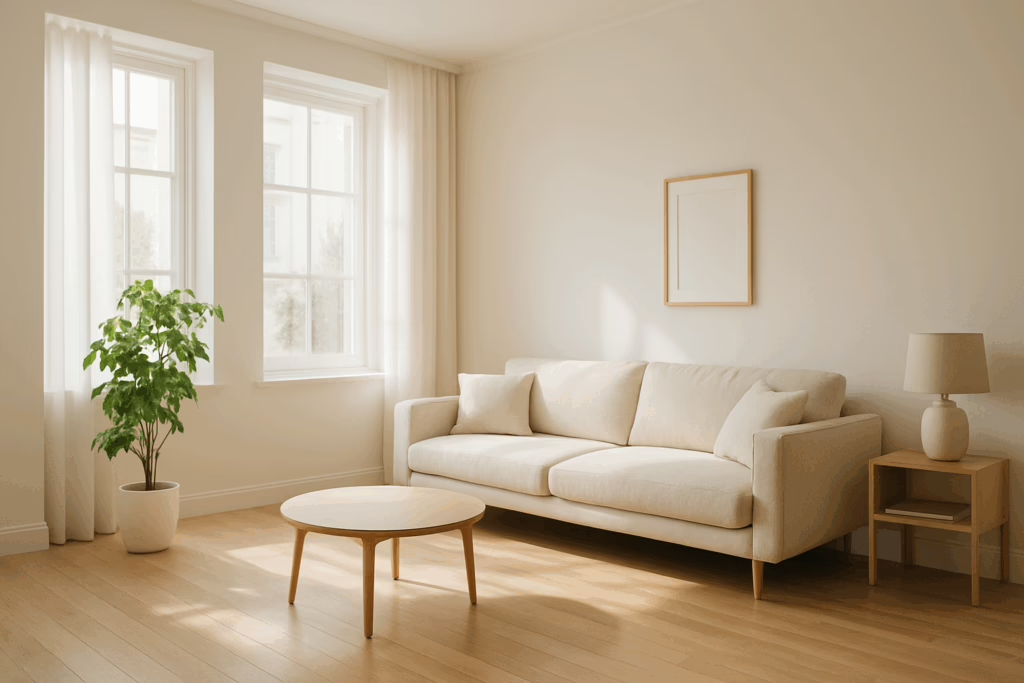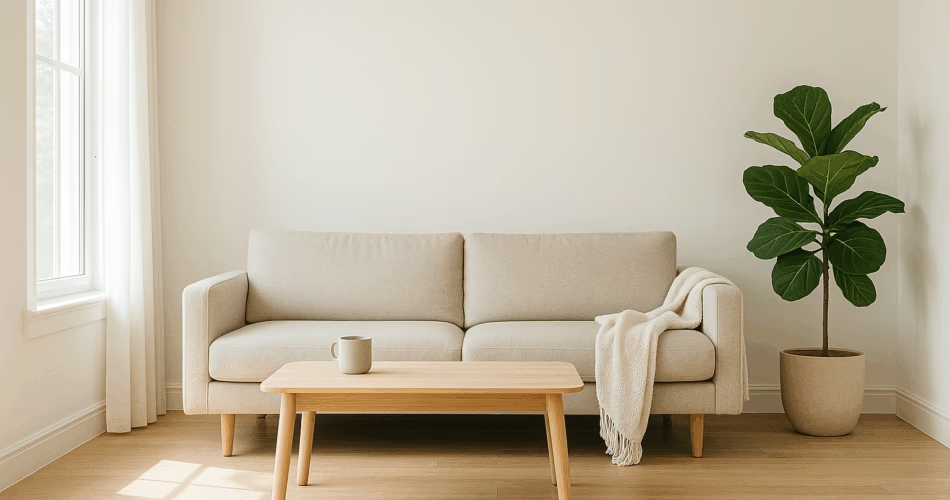Introduction
“Less is more” isn’t just a design trend; it’s a practical way to make every home feel calmer, lighter, and truly yours. In a world where clutter and chaos seem to sneak in from every corner, choosing less is more at home can be life-changing. By simplifying what fills your rooms, you create instant breathing room—physically and mentally. Many American families are now embracing this less is more philosophy, discovering that letting go of extra stuff and noise actually welcomes in a new kind of abundance: peace, comfort, and space for what matters most.
Minimalism in the home doesn’t mean empty shelves or cold, bare rooms. It’s about choosing what you love, what you use, and what brings value to your daily life. With less is more as your guide, you’ll find that each room feels more open and every day gets a little easier. This article explores ten practical ways the less is more mindset can instantly transform your home, drawing on real stories and expert advice to show that small changes make a huge difference. If you’re curious about how to begin, check out Becoming Minimalist’s beginner tips for inspiration on getting started. Now, let’s look at how less is more can change the way you live—one space at a time.

1. Less Clutter, More Calm
Less is more is the secret behind creating a truly peaceful home. Imagine walking into a living room where every surface is clear, the floor is open, and there’s no pile of magazines, toys, or electronics waiting for your attention. The difference is almost instant: your shoulders drop, your mind settles, and you can finally breathe. That’s the power of less is more in action.
For example, Sarah, a busy parent in Ohio, decided to tackle her family room using the less is more approach. She started by clearing out all but a few favorite board games and removed stacks of old mail from the side table. The result? Her kids began playing together more calmly, and the whole family found it easier to relax in the evenings. It wasn’t about making the room empty—just less crowded.
Clutter has a real impact on mental health. Studies show that when our homes are overloaded with stuff, our stress levels climb. The less is more philosophy helps you reclaim space and peace. Even decluttering just one shelf or drawer at a time can lead to noticeable calm. If you’re looking for tips on where to start, Psychology Today explains why clearing clutter can lift your mood.
2. Simplified Spaces, Easier Cleaning
Less is more makes every cleaning routine easier, faster, and much less stressful. When there’s less stuff on your counters, tables, and floors, cleaning takes minutes—not hours. The less is more approach in your home means you spend less time dusting knickknacks, moving piles, and trying to tidy up around obstacles. Even deep cleaning feels lighter when every surface is clear.
Take Mike and Jen’s kitchen in Seattle. Before they discovered the less is more method, their counters were crowded with small appliances, stacks of mail, and extra utensils. After clearing everything but the essentials, they noticed they could wipe down the counters in seconds and always knew where things belonged. The kitchen felt brighter, cleaner, and genuinely more inviting. Their Saturday chores turned into quick, simple routines instead of hours lost in frustration.
Minimalism and cleanliness often go hand in hand. Fewer objects means less dust, fewer germs, and an environment that simply feels healthier. It also reduces stress and creates space for calm. For more practical tips, The Spruce offers expert advice on minimalist cleaning habits that can help you keep your home sparkling with less effort.
3. Intentional Decor, Lasting Joy
Less is more brings a new level of joy when it comes to decorating your home. Instead of filling every wall and surface with decorations, the less is more philosophy encourages you to be intentional—choosing only items that bring you genuine happiness. A thoughtfully curated space lets every picture, plant, or object truly shine. When your home only holds what you love, it transforms into a place that lifts your mood every time you walk in.
The Johnson family in Atlanta found this out firsthand. They once had shelves crowded with photos, souvenirs, and random gifts, making their living room feel busy and disconnected. After embracing the less is more mindset, they picked a handful of their favorite photos and a few meaningful pieces of art. Suddenly, the room felt warmer and more personal, and guests commented on how peaceful and inviting it was. Keeping only what matters most helped their family reconnect with the things they truly value.
Intentional decor doesn’t mean empty spaces—it means every piece has a purpose. This approach saves you time, money, and energy while making your home a more joyful place to be. For ideas on how to decorate with intention, Apartment Therapy’s guide to intentional decor offers inspiration and practical steps for any space.
4. Maximizing Natural Light
Less is more can make your home feel brighter, more open, and even more welcoming. By embracing the less is more philosophy, you allow sunlight to flow freely throughout your living spaces. When rooms are uncluttered and furniture is arranged with intention, windows aren’t blocked and light reaches every corner. The result is a fresh, uplifting environment that naturally boosts your mood and energy.
Consider Alex’s city apartment in Chicago. At first, heavy curtains and bulky furniture made the living room feel dark and cramped. After moving to a less is more setup, Alex switched to sheer curtains and moved larger pieces away from the windows. Suddenly, natural light filled the space, making it feel bigger and more cheerful—even on cloudy days. Lower energy bills became a bonus, since lights weren’t needed during the day.
Natural light is proven to improve mental well-being, productivity, and even sleep. It also highlights the beauty of your home’s best features. Want more tips on bringing sunlight into your home? Architectural Digest shares expert advice on maximizing natural light with simple changes.
5. Smarter Storage, Spacious Feel
Less is more helps you make the most of every inch, especially when it comes to storage. Instead of stuffing closets and shelves, the less is more approach encourages using smarter storage solutions and leaving open space wherever possible. Hidden storage—like closed cabinets, under-bed bins, and sleek wall hooks—means everyday items are easy to find but don’t crowd your living areas. A room with fewer visible belongings feels instantly larger and more comfortable.
Read More..
- Beginner Minimalist? Here’s How Simplifying My Life Changed EverythingWhat Being a Beginner Minimalist Really Means Becoming a beginner minimalist isn’t about tossing all your belongings or living out of a suitcase. It’s about…
- 7 Life-Changing Truths About Minimalist Living That Gave Me My Life BackMinimalist Living: The Turning Point That Sparked It All For years, life felt like a constant race against clutter—both in my home and in my…
- 7 Tips : Minimalist Furniture, Maximum Peace: How a Clutter-Free Living Room Changed EverythingWhy a Minimalist Furniture Living Room Is More Than Just a Design Choice When someone first hears “minimalist furniture living room,” they might picture a…
For example, the Smiths in Dallas transformed their small entryway by installing a storage bench with hidden compartments and a few well-placed wall hooks. Shoes, bags, and jackets had a home, and the entryway finally felt welcoming instead of cluttered. With less out in the open, it was easier to keep things tidy and enjoy coming home.
Smart storage isn’t just about bins and baskets. It’s about choosing to keep what you really need, finding creative ways to store the rest, and enjoying the freedom that comes with open space. For more inspiration, Real Simple’s storage solutions guide offers practical tips for every area of the house.
6. Quality Over Quantity in Furnishings
Less is more can completely change how you approach furnishing your home. Rather than filling every corner with extra chairs or cheap side tables, the less is more mindset encourages you to invest in fewer, higher-quality pieces. This approach not only creates visual calm but also saves money over time, since durable furniture lasts longer and doesn’t need replacing as often.
Consider Emma, who decided to downsize her living space after her kids moved out. She sold three mismatched chairs and an old TV stand, choosing instead a single, comfortable sofa and a sturdy wooden coffee table. Suddenly, the living room felt more spacious and relaxing. Emma found she enjoyed her space more and appreciated the quality of what she owned. The money she saved by buying less went into a few special pieces she truly loved.
Choosing quality over quantity also supports a more sustainable lifestyle. When you buy fewer things, you’re less likely to contribute to waste. For more ideas on making smart furniture choices, The Good Trade has a helpful guide to sustainable and quality furnishings.
7. Streamlined Digital Life at Home
Less is more isn’t just for furniture and decor—it’s also a game changer for your digital life at home. When you have fewer devices and cleaner cords, every room feels neater and more focused. The less is more approach to technology means only keeping what you use every day and letting go of outdated gadgets, tangled chargers, and unnecessary screens. A simple tech setup makes it easier to relax, focus, and spend real time with family.
The Carter family decided to tackle their overflowing family room, which had become a graveyard for old remotes, unused tablets, and tangled cables. By donating what they no longer needed and using a single charging station, they instantly felt more organized. The room now serves as a place to connect with each other—sometimes over a favorite movie, sometimes with phones tucked away for game night.
Streamlining technology helps keep distractions at bay and puts the focus back on living. For ideas on how to create a minimalist tech setup that works for your home, Digital Trends offers tips for reducing digital clutter.
8. Minimalism in the Kitchen: Cooking Made Simple
Less is more can totally transform the way you cook and eat at home. By focusing on fewer gadgets, tools, and dishes, your kitchen becomes a place where cooking feels easy—not overwhelming. The less is more approach encourages you to keep only the essentials: your favorite pots and pans, the utensils you actually use, and the dishes that serve your needs. Suddenly, meal prep and cleanup are faster, and it’s easier to keep everything in order.
Jill, an amateur cook in California, once struggled with crowded cabinets and drawers overflowing with specialty tools she rarely used. When she applied the less is more mindset, she pared down to a handful of reliable pans and donated duplicates. Now, she can find what she needs in seconds, and every meal feels like less of a chore. Her kitchen is easier to clean, and she spends more time enjoying her food and less time searching for lost items.
A minimalist kitchen doesn’t mean you give up good food. It just means your space supports you, not the other way around. For ideas on creating a simpler cooking space, Kitchen shares practical minimalist kitchen tips to help you get started.
9. Greener Living, Less Waste
Less is more is also a powerful way to live greener and reduce waste. By choosing to buy less and keep only what you truly use, you automatically lower the amount of packaging, broken gadgets, and unused goods ending up in the landfill. The less is more approach helps you see value in reusable containers, repairing rather than replacing, and cutting down on disposable products at home.
Take Marcus in New Jersey, for example. He started using glass storage containers and cloth napkins instead of single-use plastics. By applying less is more in his kitchen and bathroom, Marcus found he produced far less trash each week and saved money on household supplies. Small changes multiplied into bigger results for both his budget and the planet.
Minimalism and eco-friendliness go hand in hand. Each time you make a mindful choice, you help the earth and make your home easier to manage. For more tips on living green with less, Earth911’s guide to minimalism and sustainability is full of simple, practical ideas.
10. More Room for Life, Not Just Stuff
Less is more means making space for living, not just for things. When your home is freed from the clutter of extra possessions, you gain room for experiences, creativity, and the people who matter most. The less is more approach invites you to ask what truly deserves a place in your home—and what you might reclaim by letting go.
Consider the Lee family, who once used their spare room for storage but decided to make a change. By clearing out old boxes and unused gear, they created a cozy reading nook complete with a comfortable chair, soft lighting, and a small bookshelf. Now, the space hosts evening story time, board games, and peaceful mornings with a cup of coffee. That simple shift brought their family closer together and made their home feel more welcoming.
Every item you remove creates new opportunities. Whether you want a corner for art, a spot to exercise, or just a place to unwind, less is more gives you the freedom to shape your home for real life. For stories and advice on starting your own minimalist journey, Becoming Minimalist’s tips can help you make the most of your space.
Conclusion
Less is more isn’t just a catchy phrase—it’s a life-changing principle that can instantly transform your home and the way you live. Throughout this article, you’ve seen how less is more brings calm, clarity, and comfort into every room. By taking small steps—decluttering a shelf, letting natural light in, or investing in quality over quantity—you create a home that supports your best life, not just your belongings.
Remember, you don’t have to go all-in overnight. Try out one or two less is more ideas this week, and notice how your space and your mood begin to shift. The less is more philosophy works in every home, no matter the size or style. And with each step, you’ll discover more time, energy, and room for what truly matters.
Ready to start your journey? You can find more practical tips and a free printable minimalist home checklist at Becoming Minimalist’s resources page. Embrace the less is more lifestyle, and let your home become a place of peace, purpose, and genuine joy.

